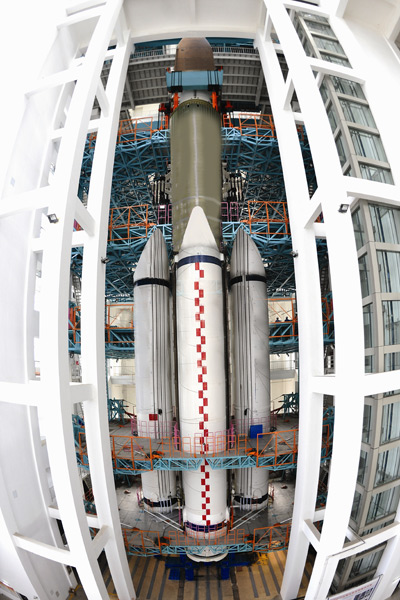Final tests completed on China's largest rocket
Updated: 2016-02-05 08:03
By Zhao Lei(China Daily)
|
|||||||||||
 |
|
The Long March 5 is shown in this undated picture being tested at the Wenchang Satellite Launch Center in Hainan province.[Photo by Sun Hao/China Daily] |
Powerful, heavy-lift Long March 5 scheduled for first flight in September
China recently concluded the final tests on its largest and most powerful rocket, the Long March 5, at the Wen-chang Satellite Launch Center in Hainan province, and will conduct the rocket's first flight in September, according to a senior project manager.
The tests started in late September last year totaled more than 130 days. They proved that the Long March 5, China's newest and most technologically advanced rocket, works well with the ground facilities at the Wenchang center, said Li Dong, a senior designer at the China Academy of Launch Vehicle Technology and head of the Long March 5 project.
The Chang'e 5 lunar probe, which will land on the moon and take samples before returning to Earth, also took part in the tests.
Li said the tests were the riskiest and most sophisticated that China has ever conducted on its rockets and involved about 300 engineers. The tests' outcome will be used to improve the first mass-production rocket, which will be launched in September, he added.
The academy will start assembling and checking the first such rocket in the near future, according to Li.
Tao Gang, general manager of Tianjin Long March Launch Vehicle Manufacturing Co, which will produce the Long March 5, said all fuel tanks of the first mass-production rocket have been made and delivered to the Tianjin assembly plant.
As the nation's first-generation heavy-lift launch system, the Long March 5 is nearly 57 meters high, with a diameter of 5 m. Boasting a liftoff weight of around 800 metric tons, it will have a maximum payload capacity of 25 metric tons in the low Earth orbit and 14 metric tons in geosynchronous transfer orbit-roughly comparable to those of the United States' Delta IV and Atlas V.
The rocket will use liquid oxygen/kerosene and liquid oxygen/liquid hydrogen as propellants for its engines, which means the gigantic spacecraft will be friendlier to the environment than previous Chinese rockets.
Once the Long March 5 becomes operational, it will be used to launch large lunar probes and the manned space station that China plans to send into orbit around 2020.
In addition to the Long March 5, China is also preparing for the debut of the smaller Long March 7 at the Wenchang center. The Long March 7 will replace the decades-old Long March 2 and Long March 3 families in commercial launch service. It also will be tasked with sending China's cargo spacecraft to the country's future space station.
The Wenchang Satellite Launch Center is China's newest launch facility, following the Xichang center in Sichuan province, the Taiyuan center in Shanxi province and the Jiuquan center in the Inner Mongolia autonomous region.
Related Stories
New rocket force gets facility to acclimate its soldiers 2016-02-01 07:55
Japan, US FMs hold talks over possible DPRK rocket 2016-01-29 15:59
Rocket Force to protect national interests 2016-01-05 08:11
PLA Rocket Force quick off the mark with drills 2016-01-05 07:57
China inaugurates PLA Rocket Force, Xi confers flags 2016-01-01 19:09
Today's Top News
Changan Automotive consolidates UK operations
Chinese students in UK enjoy fruits of the 'golden era'
Chopsticks shop draws all kinds
Foreign companies bet on China's consumers
Cruz bests Trump in Iowa, Clinton and Sanders tie
PLA revamps command system
China manufacturing activity contracts for 6th month
Sanders plays down Clinton's hold over voters in Iowa
Hot Topics
Lunar probe , China growth forecasts, Emission rules get tougher, China seen through 'colored lens', International board,
Editor's Picks

|

|

|

|

|

|






